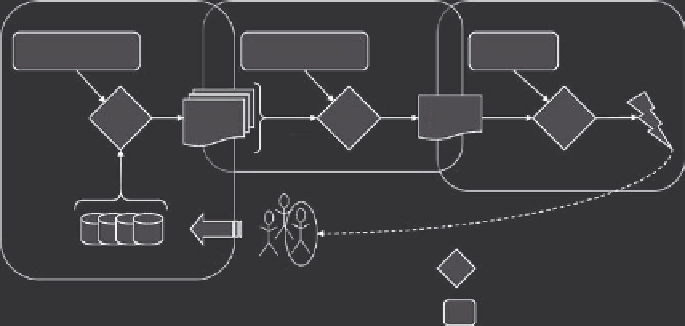Biology Reference
In-Depth Information
1. Identifying
individual cases
2. Detecting population
patterns
3. Conveying information
for action
Individual Case
Definitions
Population Pattern
Definitions
Intervention
Guidelines
Public
Health
Action
Pattern
Report
Case
Reports
Case
Detection
Algorithm
Pattern
Detection
Algorithm
Intervention
Decision
Data Describing
Population
Decision Algorithm
Population under
Surveillance
Knowledge
Figure 17.1
Public health surveillance cycle. (From Buckeridge, D. and Cadieux, G. 2007. Surveillance for
newly emerging viruses. In
Emerging Viruses in Human Populations,
Vol. 16,
ed. Edward Tabor,
The Netherlands: Elsevier, 325-343. With permission.)
process for systematically assessing and responding to acute public health
problems. For decades, the systematic steps of the epidemiologic field inves-
tigation have repeatedly been used to successfully identify the cause and
guide the response to a public health emergency (Goodman 1990). The first
three steps in the process are to
1. Confirm the diagnosis
2. Establish that an outbreak is occurring
3. Identify additional cases
These initial steps, which frequently are undertaken concurrently rather
than sequentially, are those that are most germane to the discussion of link-
ing detection to effective response. Confirming the diagnosis involves estab-
lishing that the signal that has been detected is a “true” signal. For example,
the child with a cough, conjunctivitis, and a runny nose may be suspected
of having measles, but before taking additional public health actions (such
as recommending use of gamma globulin for exposed pregnant women),
one would typically wait for disease confirmation with a positive labora-
tory test for measles. Establishing that an outbreak is occurring may require
referencing historical data, as well as examining other sources of informa-
tion. For example, a sudden uptake in school absenteeism in a rural coun-
ty's high school in Virginia in early October one year was suspected by the
newly hired local health officer to be a harbinger of a respiratory outbreak,
perhaps a novel H1N1 infection. His concerns were dispelled only after his

